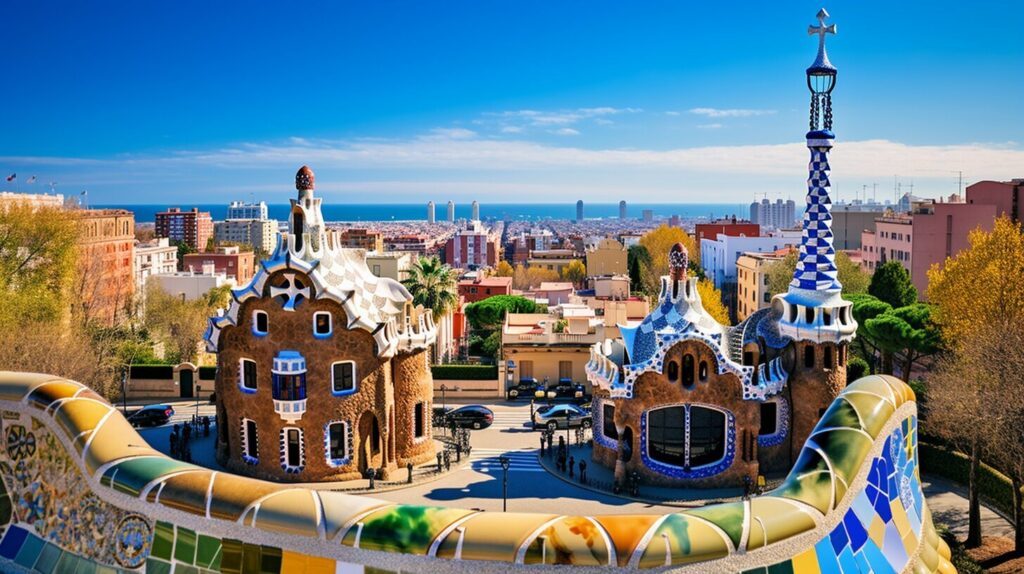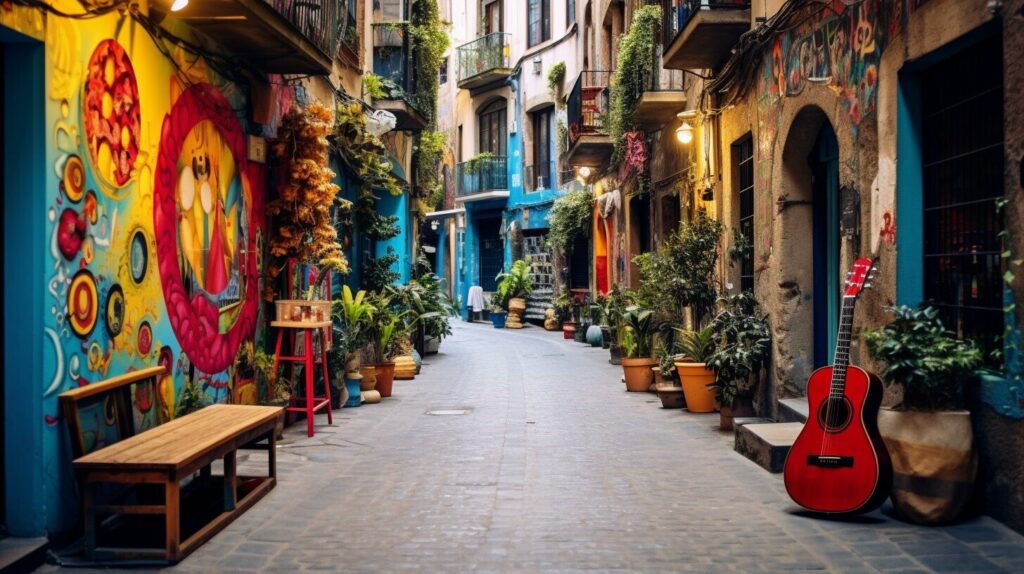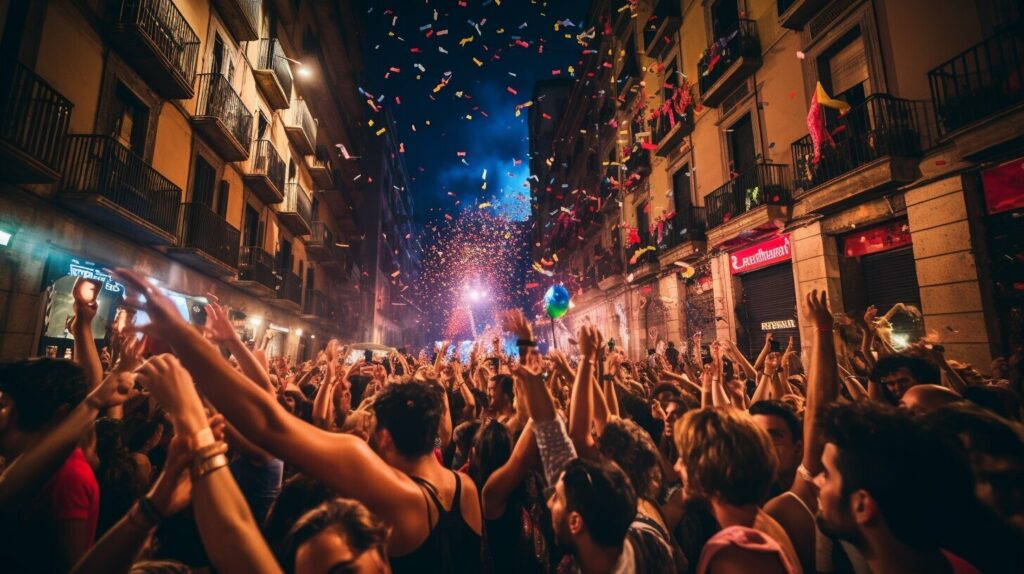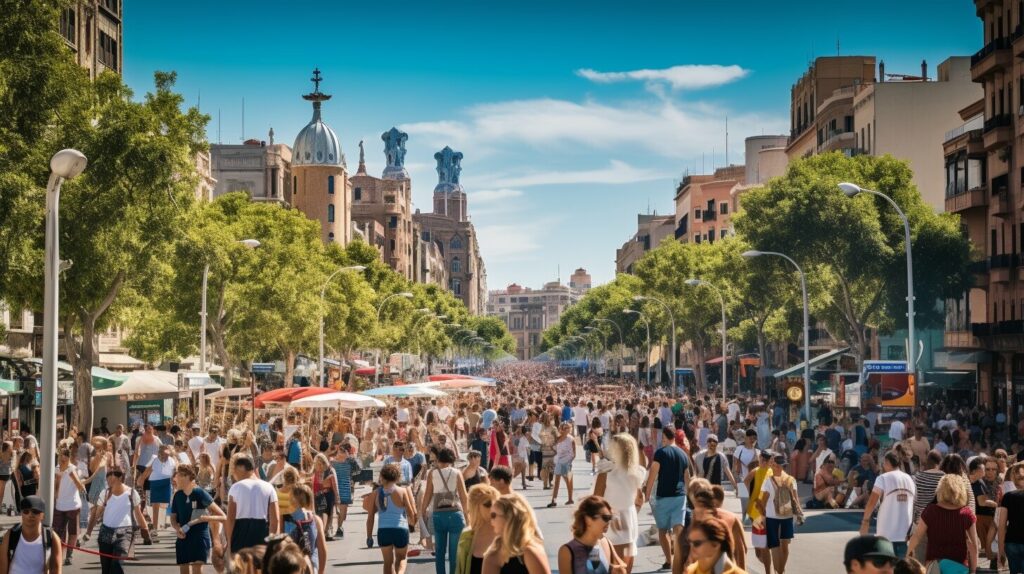Barcelona, the capital of Catalonia, is a city full of history, culture, and breathtaking architecture. It is home to some of the world’s most famous landmarks and attractions, making it a must-visit destination for travelers from across the globe.
In this article, we will take a closer look at the top places to visit in Barcelona. From Gaudí’s masterpieces to vibrant neighborhoods and beautiful parks, we have got you covered.
Key Takeaways:
- Barcelona is a city full of history, culture, and breathtaking architecture.
- Gaudí’s masterpieces, such as Sagrada Familia and Park Güell, are must-see attractions.
- La Rambla and the Gothic Quarter are vibrant neighborhoods with plenty of things to see and do.
- Camp Nou, the famous stadium of FC Barcelona, is a must-visit for football enthusiasts.
- Montjuïc Hill and Park de la Ciutadella provide a tranquil retreat from the busy city.
- The Magic Fountain of Montjuïc is a mesmerizing light and music show that is not to be missed.
- The Picasso Museum offers an extensive collection of artworks by the renowned artist.
Sagrada Familia
The Sagrada Familia is undoubtedly one of the most iconic landmarks in Barcelona. Designed by the renowned architect Antoni Gaudí, the cathedral is still under construction and has been for over 135 years. Its unique architecture and intricate details make it a must-see attraction for visitors to the city.
The Sagrada Familia has a fascinating history, having been started in 1882 and only a quarter completed by the time of Gaudí’s tragic death in 1926. Construction continued through the Spanish Civil War and into modern times, with architects and designers continually working to bring Gaudí’s vision to life.
Visitors can explore the cathedral’s exterior and interior, with its towering spires and stunning stained glass windows. The Nativity Façade, which features scenes from the birth of Jesus, is exquisitely detailed and is the only part of the cathedral that was completed during Gaudí’s lifetime. The Passion Façade, by contrast, is more austere and was designed by architect Josep Maria Subirachs in the 1980s.
Inside the cathedral, visitors can marvel at the intricate details of the columns and the ceiling, which is intended to resemble a forest canopy. The central nave rises to a height of over 200 feet, and the light filtering through the stained glass creates a magical atmosphere.
Visiting the Sagrada Familia
The Sagrada Familia is open to visitors every day of the week, although hours vary depending on the season. Visitors are advised to book their tickets in advance, as the cathedral is a popular attraction and can get very busy. It is also worth considering a guided tour, as this can provide insight into the history and design of the cathedral.
It is also important to dress appropriately when visiting the Sagrada Familia. As a place of worship, visitors are expected to dress respectfully, covering their shoulders and knees.
Park Güell
One of the most enchanting places to visit in Barcelona is Park Güell. This colorful and whimsical park was designed by the famous Catalan architect, Antoni Gaudí, and is considered to be one of his greatest works. It was originally envisioned as a housing development, but eventually became a public park.
The park is characterized by its unique blend of natural forms, modernist architecture, and vibrant colors. The most famous feature of the park is the colorful mosaic tiles that cover the undulating bench that wraps around a large terrace, providing a stunning panoramic view of the city.
Other notable features of the park include two Hansel and Gretel-like gatehouses at the entrance, a winding staircase that leads to the top of a hill, and a dragon statue that has become an iconic symbol of the park.
Visitors to the park can spend hours wandering the paths and stairs, discovering hidden corners and enjoying the playful structures scattered throughout. The park can get quite crowded, especially during peak tourist season, so it is recommended to arrive early in the morning or late in the afternoon to avoid the crowds.
La Rambla
La Rambla is one of Barcelona’s most famous streets, known for its bustling atmosphere and variety of street performers. This vibrant pedestrian walkway stretches from Plaça de Catalunya to the Christopher Columbus Monument at the port, and is lined with shops, restaurants, and cafes.
Visitors to La Rambla can expect to encounter a range of street performers, from living statues to musicians and dancers. The street is also home to several notable landmarks, including the iconic La Boqueria market, the Gran Teatre del Liceu, and the Plaça Reial.
La Boqueria Market
One of the highlights of La Rambla is La Boqueria market. This vibrant and colorful market is a feast for the senses, with endless stalls selling fresh produce, meat, fish, and more. Visitors can wander through the aisles, sampling local specialties and chatting with vendors.
| Opening Hours: | Monday to Saturday, 8am-8:30pm |
|---|---|
| Location: | La Rambla, 91, 08001 Barcelona |
Whether you’re looking for a quick snack or want to stock up on souvenirs, La Boqueria market is a must-see destination on La Rambla.
Exploring La Rambla is a quintessential Barcelona experience, offering a glimpse into the bustling life of this vibrant city. With its lively atmosphere and diverse offerings, there’s something for everyone on this famous street.
Gothic Quarter
Take a step back in time as you stroll through the charming Gothic Quarter, also known as Barri Gòtic. This historic neighborhood is filled with narrow streets, medieval architecture, and a unique ambiance that transports you to a different era.
One of the main attractions in the Gothic Quarter is the stunning Barcelona Cathedral, a grand religious site that dates back to the 13th century. Visitors can enter the cathedral for free, but guided tours are available for those who want to learn more about its history and significance. The square in front of the cathedral, Pla de la Seu, is a great spot to rest and take in the impressive surroundings.
Another must-see site in the Gothic Quarter is the Plaça Reial, a beautiful square lined with palm trees, restaurants, and cafes. The square is a popular spot for locals and tourists alike, especially at night when the vibrant nightlife comes alive.
If you’re interested in art and history, the Picasso Museum is also located in the Gothic Quarter. The museum houses an impressive collection of artworks by the renowned artist, including many from his early years.
Barcelona Cathedral
The Barcelona Cathedral is a stunning example of Gothic architecture and is widely considered one of the city’s most beautiful buildings. The cathedral dates back to the 13th century and was completed in the 15th century with the addition of the beautiful façade.
| Address | Pla de la Seu, s/n, 08002 Barcelona, Spain |
|---|---|
| Hours | Monday to Friday: 10am-5:30pm; Saturday: 10am-5pm; Sunday: 2pm-5pm |
| Admission | Free entry, guided tours available for €9-€14 |
Plaça Reial
The Plaça Reial is a bustling square that’s popular with both locals and tourists. With plenty of restaurants, cafes, and bars, it’s a great spot to enjoy some food and drinks while taking in the vibrant atmosphere. The square is also home to the Font de les Tres Gràcies fountain and two iconic lampposts designed by none other than Antoni Gaudí himself.
| Address | Plaça Reial, 08002 Barcelona, Spain |
|---|---|
| Hours | Open 24 hours |
| Admission | Free |
Picasso Museum
The Picasso Museum is a must-visit for art lovers, with an extensive collection of artworks by the famous artist. The museum is housed in five medieval palaces and has over 4,000 pieces on display, including many from Picasso’s early years.
| Address | Carrer Montcada, 15-23, 08003 Barcelona, Spain |
|---|---|
| Hours | Tuesday to Sunday: 9am-7pm; Closed on Mondays |
| Admission | €12 for general admission; free on the first Sunday of each month and on Thursdays from 6pm-9:30pm |
Casa Batlló
If you’re a fan of Gaudí’s impressive architectural style, a visit to Casa Batlló is a must. This iconic building, located in the heart of Barcelona, is a masterpiece of modernist design and a true reflection of the artist’s unique vision.
As you approach the building, its eye-catching facade will immediately draw you in. The colorful ceramic tiles, undulating curves, and intricate wrought-iron details make for a truly unforgettable sight. Once inside, you’ll have the opportunity to explore the various floors and rooms of the building, each more impressive than the last.
One of the highlights of the tour is the famous Dragon’s Back rooftop, which offers stunning panoramic views of the city. Here, you’ll also be able to admire the building’s iconic chimneys, which are said to resemble the helmets of medieval knights.
If you’re interested in learning more about the history and design of Casa Batlló, guided tours are available in various languages. They offer a unique opportunity to gain insight into Gaudí’s creative process and the fascinating stories behind some of the building’s most notable features.
Camp Nou
Camp Nou is a world-famous stadium located in the Les Corts neighborhood of Barcelona. It is the home of FC Barcelona, one of the most successful and popular football clubs in the world.
The stadium has a capacity of over 99,000, making it the largest stadium in Spain and one of the largest in Europe. It has hosted numerous important football matches, including the UEFA Champions League finals and the 1982 FIFA World Cup.
For football fans, a visit to Camp Nou is a must. Guided tours are available, providing access to the stadium, museum, and trophy room. The museum features an extensive collection of FC Barcelona memorabilia, including jerseys, trophies, and photos of the team’s greatest moments.
Camp Nou is a truly unforgettable experience for anyone who loves football and wants to get a closer look at one of the world’s most legendary clubs.
Montjuïc Hill
Majestic Montjuïc Hill is one of the city’s most scenic spots, offering panoramic views of Barcelona and the Mediterranean Sea.
The hill has played a significant role in the city’s history, with the Montjuïc Castle serving as an important fortress during various historic battles and being used as a prison during the Franco regime.
Montjuïc is also home to the Olympic Stadium, which hosted the 1992 Summer Olympics, and the Palau Sant Jordi, a popular concert venue.
Visitors can reach the top of Montjuïc via cable car or funicular, both of which provide stunning views along the way.
The Olympic Ring:
Located at the foot of the hill, the Olympic Ring features a cluster of sporting facilities built for the 1992 Summer Olympics.
| Facility | Description |
|---|---|
| Olympic Stadium | The main stadium for the 1992 Olympics, with a capacity of over 60,000 spectators. |
| Palau Sant Jordi | A multi-purpose indoor arena and concert venue with a unique red triangular roof. |
| Palau dels Esports de Barcelona | A smaller sports arena used for basketball and other events. |
| Calatrava Tower | A telecommunications tower designed by Santiago Calatrava, standing at 136 meters tall. |
Whether exploring the Olympic history or enjoying the stunning views, Montjuïc Hill is a must-visit destination in Barcelona.
Park de la Ciutadella
If you’re looking for a green oasis in the heart of Barcelona, look no further than Park de la Ciutadella. As the largest park in the city, it offers plenty of space to relax, play, and explore.
The park was originally created in the 19th century on the grounds of a former military fortress, and it has since become a beloved destination for locals and tourists alike. One of its most recognizable features is the Cascada fountain, which was designed by Josep Fontserè and includes sculptures by renowned artist Antoni Gaudí.
Aside from its natural beauty, Park de la Ciutadella also offers a variety of activities and attractions. Visitors can rent rowboats on the lake, enjoy a picnic on the grass, or explore the impressive greenhouses and gardens within the park.
The Barcelona Zoo
For animal lovers, the Barcelona Zoo is a must-see attraction within Park de la Ciutadella. The zoo has a wide variety of animals, including lions, tigers, giraffes, and elephants. It also has a special focus on conservation and education, with many exhibits highlighting endangered species and their habitats.
One of the zoo’s most popular attractions is the dolphin show, which takes place in a large outdoor stadium. Visitors can watch as the dolphins perform tricks and stunts in the water, accompanied by music and narration.
Tickets for the Barcelona Zoo can be purchased online or at the entrance to the park. The zoo is open every day of the year, with hours varying depending on the season.
Magic Fountain of Montjuïc
One of Barcelona’s most popular nighttime attractions, the Magic Fountain of Montjuïc is a must-see for visitors of all ages. Located at the foot of Montjuïc Hill, this stunning fountain offers a mesmerizing display of water, light, and music that is sure to enchant and delight.
The fountain’s performances typically take place on Thursday through Sunday evenings, with multiple shows each night. Each performance features a unique program of music and color, showcasing expertly choreographed water jets and light displays that dance in time to the music. The shows are completely free to the public, making them an excellent option for budget-conscious travelers.
If you plan to visit the Magic Fountain of Montjuïc, be sure to arrive early to secure a good viewing spot. The fountain’s popularity means that it can get quite crowded, especially during peak tourist seasons.
For the best views, head to the open plaza directly in front of the fountain. You’ll be able to see the water jets and light displays up close, and enjoy a panoramic view of the surrounding cityscape. Alternatively, consider watching the show from a higher vantage point, such as the nearby hillside or the balcony of the National Palace of Montjuïc.
Whether you’re traveling solo, with friends, or with family, the Magic Fountain of Montjuïc is a can’t-miss attraction that is sure to create lasting memories. So grab a blanket, some snacks, and settle in for an unforgettable evening of entertainment and wonder.
Picasso Museum
The Picasso Museum is a must-visit attraction for art lovers in Barcelona. Located in the Gothic Quarter, this museum showcases an extensive collection of artworks by the renowned artist Pablo Picasso. The museum’s collection includes paintings, sculptures, and ceramics, providing a comprehensive overview of Picasso’s artistic development.
One of the highlights of the museum is the Las Meninas series, a set of 58 interpretations of Diego Velázquez’s famous painting. Visitors can also admire Picasso’s Blue Period works, such as the iconic painting “La Vie.”
The museum is housed in a series of Gothic mansions, providing a unique backdrop for the artworks on display. Visitors can also explore the charming courtyards and gardens within the museum complex.
The museum offers guided tours and audio guides for a more in-depth experience. It is recommended to book tickets in advance, especially during peak tourist season.
Conclusion
Barcelona is a city that offers a unique blend of history, culture, and modernity, with an abundance of must-see places to visit. From Gaudí’s masterpieces like the Sagrada Familia and Park Güell, to the bustling atmosphere of La Rambla and the charming narrow streets of the Gothic Quarter, there is something for everyone in this city.
Other noteworthy places to visit include the iconic Casa Batlló, the famous Camp Nou stadium, the panoramic views from Montjuïc Hill, the tranquil oasis of Park de la Ciutadella, and the mesmerizing light and music shows at the Magic Fountain of Montjuïc.
No visit to Barcelona is complete without experiencing the extensive collection of artworks at the Picasso Museum. Overall, all these attractions offer a diverse and rich range of experiences that make for a truly memorable visit to this vibrant city.
FAQ
Q: What are the must-see attractions in Barcelona?
A: The top places to visit in Barcelona include Sagrada Familia, Park Güell, La Rambla, Gothic Quarter, Casa Batlló, Camp Nou, Montjuïc Hill, Park de la Ciutadella, Magic Fountain of Montjuïc, and the Picasso Museum.
Q: What is the significance of Sagrada Familia?
A: Sagrada Familia is Gaudí’s masterpiece and one of Barcelona’s most famous landmarks. It features unique architecture and holds great historical and cultural value.
Q: What is special about Park Güell?
A: Park Güell is another masterpiece by Gaudí and is known for its colorful mosaic tiles. It offers scenic views and showcases stunning design elements.
Q: What can I expect on La Rambla?
A: La Rambla is Barcelona’s most famous street, known for its bustling atmosphere, shops, restaurants, and vibrant street performers. It’s a must-visit location for experiencing the city’s energy.
Q: What is the Gothic Quarter known for?
A: The Gothic Quarter, also known as Barri Gòtic, features medieval architecture, narrow streets, and a charming ambiance. It is home to various historic buildings, squares, and landmarks.
Q: What makes Casa Batlló special?
A: Casa Batlló is one of Gaudí’s renowned residential buildings, known for its unique modernist architecture. Visitors can explore its distinct features and take guided tours of the interior.
Q: Tell me more about Camp Nou.
A: Camp Nou is the famous stadium of FC Barcelona and holds great historical significance. It offers guided tours and museum exhibits for football enthusiasts.
Q: What is worth seeing on Montjuïc Hill?
A: Montjuïc Hill offers panoramic views of Barcelona and is home to attractions like the Olympic Stadium. Visitors can explore its historical importance and enjoy various activities.
Q: Why should I visit Park de la Ciutadella?
A: Park de la Ciutadella is Barcelona’s largest park, providing a green oasis within the city. Its tranquil atmosphere and notable features make it a perfect spot for relaxation and exploration.
Q: What can I expect at the Magic Fountain of Montjuïc?
A: The Magic Fountain of Montjuïc is famous for its mesmerizing light and music shows. Information about showtimes, accessibility, and the best viewing spots can be found on-site.
Q: What can I see at the Picasso Museum?
A: The Picasso Museum houses an extensive collection of artworks by the renowned artist. Visitors can appreciate Picasso’s works and explore temporary exhibitions during their visit.
Conclusion
Barcelona offers a wide range of attractions and sites for visitors to explore. Whether it’s the iconic landmarks like Sagrada Familia and La Rambla, the charm of the Gothic Quarter, or the artistic experiences at the Picasso Museum, the city promises a memorable experience. Don’t miss out on the top places to visit in Barcelona for an unforgettable trip.




